|
|

|
Porsche, and the Porsche crest are registered trademarks of Dr. Ing. h.c. F. Porsche AG.
This site is not affiliated with Porsche in any way. Its only purpose is to provide an online forum for car enthusiasts. All other trademarks are property of their respective owners. |
|
|
| Larry.Hubby |
 Nov 29 2010, 10:26 PM Nov 29 2010, 10:26 PM
Post
#1
|
|
Member who doesn't post much, but has a long time in 914s   Group: Members Posts: 188 Joined: 24-November 04 From: Palo Alto, CA Member No.: 3,172 Region Association: Northern California |
My first encounter with bump steer came in 1971. I was 26, my car was about a year old, and I, like so many early owners, had gotten tired quickly of the tipi-toy handling that you got with the original suspension configuration. I had already replaced the 155SR 15 tires on 4.5” rims that the car was delivered with, added a factory front sway bar with the help of a friendly PCA member that had a 914 himself, and ditched the original shocks in favor of Konis. I had also scheduled a trip down to LA to buy some of the few aftermarket 914 suspension parts available at the time from Richie Ginther Racing in Culver City.
As I picked up the 22mm torsion bars and 180 lb/in springs that I had ordered, the Ginther parts guy said, “Do you want the rack spacers too?” “What do those do?” I asked. “They take out the bump steer,” he replied. Hmmm. Oh well, why not? They’re only $3.25 each (1971, remember). “Sure!” I say, and they go into the box along with the other parts. Later, on the way back up US101 to the Bay Area, I started chewing on the parts guy’s remark, which had left me feeling vaguely unsettled at the time. Why, I asked myself, would Porsche, who builds cars for knowledgeable enthusiast drivers, and who had at least a semi-clean sheet of paper in front of them when they started (OK, they used the front suspension pieces from the 911, but that’s supposed to be a higher performance model and shouldn’t compromise the design), design something that needed to be corrected, and is fairly easy to correct ($3.25 or even $6.50 can’t do much, even in 1971), into a production car? Maybe Porsche put it in intentionally. So, is it actually going to be dangerous to take it out, in which case why didn’t the Ginther guy warn me? Oh well, perhaps I’ll find out when I go to install those 5/8” thick spacers. Back home, it turns out to be a huge hassle to install the rack spacers because the rack can’t be raised 5/8” without hitting the top of the large central hole in the floor pan that the steering shaft enters through. I wind up grinding off about 3/8” of the sheet metal around the top of the hole to get enough clearance to mount the spacers. On the phone the next day, the Ginther guys claim they’ve never had to do that on a six cylinder car, but have never even tried it on a four. If actually true and due to a real design difference, this could be one of the most esoteric differences between the fours and sixes (I don’t see how it could be, however. PET shows the part numbers for both the steering rack and the front body floor as the same for the 4’s and 6’s). What a pain, but at least now I have immunity to tow changes when I raise or lower my ride height, right? Fast forward to now. I’m 65, the car is 40, is a converted 3.0 six, and now wears 205/50 and 225/50 tires on 7” and 8” rims. The ride height is 2.25” lower than stock, and has been for over 25 of those 40 years. I still run the Ginther torsion bars, springs, and rack spacers, and the car has been aligned many times. Being a card-carrying old fart now, I’m getting tired of wrestling those fat tires at slow speeds in parking lots, and seriously want to install power steering. I even bought a used VW Corrado PS rack on eBay to start the project. The first thing I did when it arrived was measure the distance between the inner tie rod joints and compare it to the spec for the factory 914 rack. It turns out to be 40mm larger than the stock 914 dimension. Hmmmm, won’t that cause…bump steer? All right, time to understand this bump steer thing. Since I did lots of computer simulations at work before I retired, I thought I would just write out the equations, measure the car, and calculate what happens. Then I thought that someone somewhere must have already written a program that can do this, and that you can download for free. It turns out several people have done this, but all of them that I found want a few hundred dollars to download and use their programs. I did find one, named Suspension Analyzer (available here: http://performancetrends.com/download.htm#drp), that allows you to download the program and use it for free for a ten-day trial period. Hmmmm, again. If armed with all the necessary data, a person could do quite a bit of analysis in ten days, particularly if all he wanted to do was find out how much bump steer he has and what he has to do to get rid of it. So, I spend a half-day under the front end of the car with a tape measure and a machinist’s square to locate the points shown below: 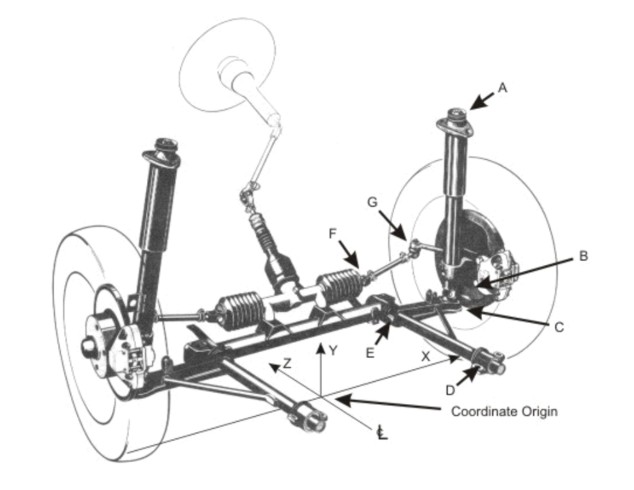 The way the program works is very straightforward. It has a pre-defined mode for strut front suspensions, and uses the coordinate system shown in the figure, which has its origin on the center line of the car at the fore and aft location of the line that joins the two centers of the front tire contact patches. The coordinate, x, is entered as positive for both right and left suspension elements. That is, no negative x-values are used, so the program essentially uses a right-hand coordinate system for the right wheel, and a left-hand one for the left wheel. I simply invoked symmetry, so that the same values were entered for both wheels. You don’t have to do this, the program will allow you to enter unique data for each wheel, front and rear (if you buy the full program, the demo version will do only the front), and will then calculate what happens for the whole car. My goals were more modest, so I only measured one front wheel and entered that data for both. One quirk the program has is that it requires the point, B, shown above, which it calls the “bottom of the McPherson strut”. The quirky thing is that B cannot be co-incident with C, which it calls the “lower ball joint”. If it is, some equation apparently becomes singular, and the program gives up and refuses to calculate or graph anything. Just what point B is supposed to be, and why they need it in addition to C, isn’t well-explained in the program manual, but, playing around with the program for a few days, I found that everything works as it should so long as the line joining points A and C passes through both point B and the line joining the centers of the two front tires when the wheels are pointed straight ahead (Z = 0 and Y = the rolling radius of the front tire). An error I was making initially is placing point C at Z = 0. C cannot be at Z = 0 because of the finite castor angle, as you can see from this drawing: 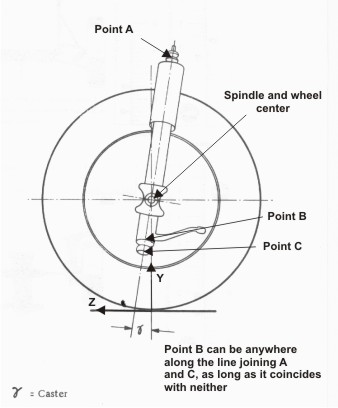 As I said already, B needs to be on the line that joins A and C. If it isn’t, the program will interpret that as misalignment between the strut and the spindle. In particular, if B is off even a small amount in Z, the program will interpret that error as a static toe angle that’s built into the strut and has nothing to do with the entered nominal toe-in for the front wheels or with any steering input. This sensitivity to the z-coordinate is the reason I’ve specified some of the locations on calculated points in the data below to so many decimal places. If point B is correctly on the strut axis, a wide range of locations for B all seem to give the same results (presumably, B needs to be far enough from A for the two not to run into each other at maximum strut compression). However, it’s tempting to still set B as close to C as possible because the graphics the program draws then look the most like they should. I wound up using a point 1” in y above C. The values shown in the table below should work if punched into the program. I measured the locations of all the other points shown in the figure on my car, and then calculated what they would have been on a stock 914, based on the known difference in ride height, tire size, and camber angle (a car lowered as much as mine cannot be brought back to the nominal camber setting without modification because of limited range of adjustment at the top of the front shocks). In each case I adjusted the location in x and z of point A to get the nominal camber (0° for stock, -1° for my car) and castor (6°) values, just as you would if you were actually aligning the car. And, of course, every time you change point A you have to change both B and C as well in order to keep all three of them on the correct straight line. The values I came up with for all the relevant points are as follows: 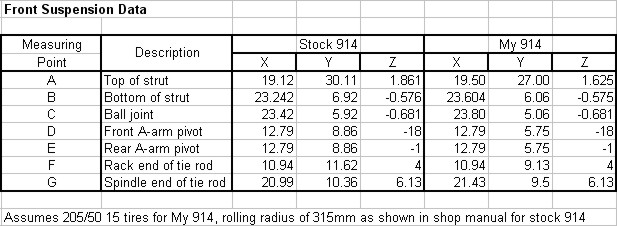 Note that the y values for points D and E are different between the two cases by more than the 2.25” in ride height that I quoted. This is because .86” of this difference is due to the difference in tire size. Plugging these into the program, I could calculate the amount of steering produced by deflecting the suspension vertically while the wheels are nominally pointed straight ahead, which is to say, the amount of the bump steer. The following graph shows the results for the various cases I was interested in: 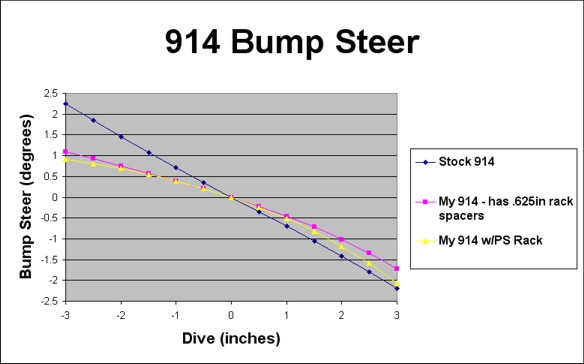 Dive is what the program calls y-axis deflection of the car body, rather than the suspension. So, positive dive is downward deflection of the body, but upward deflection of the wheels relative to the body. The bump steer is calculated in degrees, and positive bump steer corresponds to toe-in. So, we can see several things immediately. The stock 914 does indeed have lots of bump steer, more than 2° over the full 3” of suspension travel. I found this result surprisingly large, but I checked my measurements several times and I presume at this point that they are close to right. My lowered 914 with the Ginther rack spacers does have less, although not a lot less, and the difference is mainly at negative dive, when the wheels are unloaded. And here, I’ve been assuming for nearly 40 years that I had none! Probably, the much firmer suspension provided by the 22mm torsion bars has been making it feel like less by reducing the dive the car experiences enough to make up for the still-large bump steer rate. And probably, the 5/8” spacers that Ginther sold were just the thickest spacers that would fit (in most cars perhaps), and if I’d been able to ask someone who really knew, they would have admitted that the spacers don’t take all the bump steer out, just get you back to a bit better than stock after you lower the ride height. The effect of the stock geometry is to produce tow-out (negative bump steer) when the suspension is compressed (positive dive), which, since it’s applied to the front suspension, would correspond to under-steer when cornering hard. Perhaps this was regarded by Porsche as a safer situation than the reverse for the average driver, considering that the 914 is a rear weight-bias car. The other thing I was interested in was how going to the VW Corrado power steering rack with its 40mm of extra length between the inner tie rod joints would change things. Surprisingly, the answer is not very much. It does up the bump steer noticeably, but, the difference between the bump steer using this rack in my car at the same position as the rack I have now, and that my car currently has is small compared to the absolute level of bump steer in either case. So, I don’t really need to consider shortening the rack. One of the nice features of this program is that it can optimize many different things automatically, bump steer among them. You specify what you want to vary in order to achieve improvement, what you want to improve, and what range of suspension movements in dive and roll you want the program to consider while optimizing; and the program will do the rest. For each of the three cases shown above; the stock 914, my 914, and my 914 with the Corrado rack; I asked the program to move the steering mechanism up, and then instead to drop the outer tie rod ends, in both cases to minimize the total bump steer. The results predict the optimum rack spacer thicknesses and tie rod end drops, respectively, which are the two standard methods of correcting bump steer that you can go buy parts for. The three graphs below show the bump steer after correction by both methods for each case: 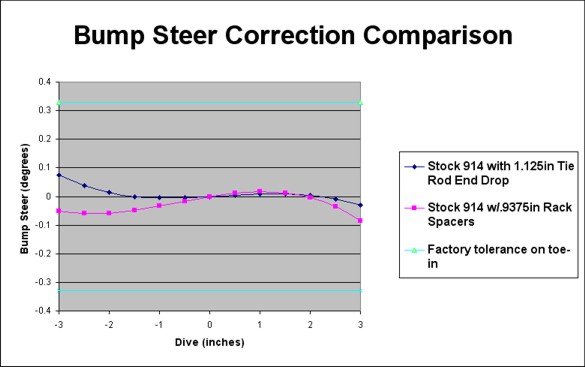 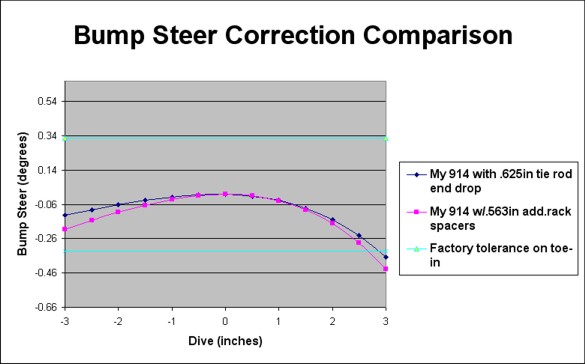 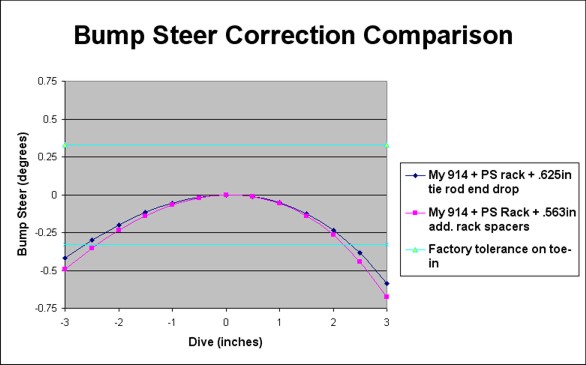 Note the greatly expanded vertical axis in each case. As you can see, it’s possible to achieve an enormous improvement in bump steer correction in all three cases by either method. For the stock 914, it’s possible to reduce the residual to a small fraction of the factory tolerance on the toe setting with rack spacers .9375” thick (not .625”), or with a tie rod end drop of 1.125”. For my lowered car, which already has .625” thick rack spacers in place, the optimum additional rack spacers would be .563” thick for a total of 1.188”, and the optimum tie rod end drop would be .625”. Mounting the VW power steering rack in my car at the same height as the present rack would not change these optimum values, only the amount of the residual bump steer. The correction for my car with either rack isn’t quite a nice as that for the stock 914, but it’s still quite close to being within the factory toe setting tolerance, particularly if I’m willing to adjust the static toe to the upper limit of the tolerance, i.e. 1/3° of toe-in. Interestingly enough, the two methods don’t yield exactly the same results for the same case, the tie rod end drop method always being a tiny, and almost certainly insignificant, bit better. This could be a real, subtle geometric effect, or it could simply be because the program uses a minimum increment size of 1/16” when it varies dimensions. It could be that this level of granularity just happens to find solutions closer to the true optima in the tie rod end drop cases. In any event, dropping the tie rod ends has another important advantage over using rack spacers, in that there’s room to do it. I’m pretty confident, based on my experience 39 years ago, that rack spacers 1.188” or even .9375” thick will not fit without some pretty savage cutting of sheet metal, if you’re using the stock Porsche rack. An unanticipated bonus that comes with converting to the VW PS rack is that it’s enough smaller in diameter than the stock rack, that it CAN be mounted high enough in the car without cutting anything (except, of course, the new hole for the steering input shaft that’s required because the shaft is no longer in the center). So, making the mounting bracket such that it positions the VW rack properly will eliminate the need for the dropped tie rod end kit. Another interesting thing is that the optimum values and residual bump steer performance are as different as they are for the stock 914 and for my car. This is due to geometry changes as you lower the ride height. I verified that by letting the program lower the ride height on the stock 914 to the same height as my car, recalculating the locations of points A, B, and C to restore the correct camber and caster, and then re-optimizing. The values found then are the same as those for my car. I didn’t reproduce any of the graphics of the suspension that the program produces, but these revealed that, at the optimum settings for bump steer, the tie rods and the control arms are always nearly, but not quite, parallel. Presumably, if the tie rods were the same length as the control arms and parallel to them, there would be no bump steer at all. The tie rods aren’t the same length as the control arms, and the difference varies with the ride height because the length of the tie rod must change as the car is lowered in order to keep the same static toe angle. For those of you who might want to know how quickly the bump steer varies as a function of rack position or tie rod end drop, I calculated the following two series showing what happens at various rack spacer thicknesses and tie rod end drop amounts on my 914. Although I didn’t repeat enough of the calculations for the other cases to show the same data for them, I did verify that the sensitivity is very similar. 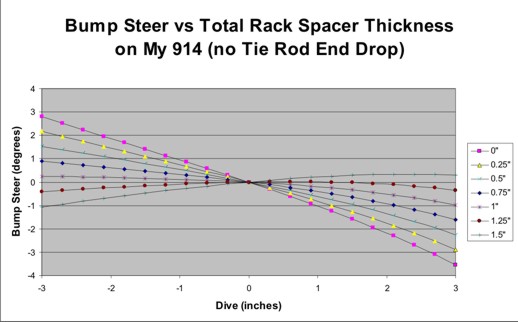 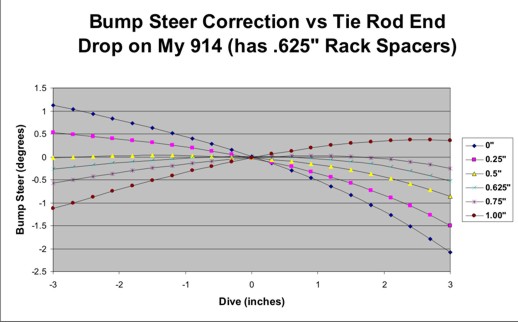 I'll post my efforts at power steering installation as soon as I have it all working. |
  |
Replies(1 - 19)
| JRust |
 Nov 29 2010, 11:18 PM Nov 29 2010, 11:18 PM
Post
#2
|
|
914 Guru      Group: Members Posts: 6,316 Joined: 10-January 03 From: Albany Oregon Member No.: 129 Region Association: Pacific Northwest 
|
Holy Hell (IMG:style_emoticons/default/WTF.gif) . What a write up (IMG:style_emoticons/default/blink.gif) . You definately put some time into it. I see an instant classic on bump steer. Thanks for going so indepth (IMG:style_emoticons/default/biggrin.gif)
|
| championgt1 |
 Nov 29 2010, 11:21 PM Nov 29 2010, 11:21 PM
Post
#3
|
|
Don't embarrass me Filmore!     Group: Members Posts: 2,681 Joined: 3-January 07 From: Tacoma, Washington Member No.: 7,420 Region Association: Pacific Northwest |
(IMG:style_emoticons/default/agree.gif) Put it in the classics!
|
| Tom_T |
 Nov 30 2010, 12:35 AM Nov 30 2010, 12:35 AM
Post
#4
|
|
TMI....      Group: Members Posts: 8,321 Joined: 19-March 09 From: Orange, CA Member No.: 10,181 Region Association: Southern California 
|
(IMG:style_emoticons/default/agree.gif)
... in the classics Andy, what a treatise! Give the man an honorary PhD!!!! (IMG:style_emoticons/default/biggrin.gif) |
| SirAndy |
 Nov 30 2010, 12:36 AM Nov 30 2010, 12:36 AM
Post
#5
|
|
Resident German                          Group: Admin Posts: 42,199 Joined: 21-January 03 From: Oakland, Kalifornia Member No.: 179 Region Association: Northern California |
I calculated the following two series showing what happens at various rack spacer thicknesses and tie rod end drop amounts on my 914 So if i read this correctly, it looks like the optimal result would be with a 0.625" Tie Rod Spacer and no rack spacer. Yes? No? (IMG:style_emoticons/default/confused24.gif) Nice writeup btw.! (IMG:style_emoticons/default/first.gif) |
| Larry.Hubby |
 Nov 30 2010, 01:11 AM Nov 30 2010, 01:11 AM
Post
#6
|
|
Member who doesn't post much, but has a long time in 914s   Group: Members Posts: 188 Joined: 24-November 04 From: Palo Alto, CA Member No.: 3,172 Region Association: Northern California |
I calculated the following two series showing what happens at various rack spacer thicknesses and tie rod end drop amounts on my 914 So if i read this correctly, it looks like the optimal result would be with a 0.625" Tie Rod Spacer and no rack spacer. Yes? No? (IMG:style_emoticons/default/confused24.gif) Nice writeup btw.! (IMG:style_emoticons/default/first.gif) Andy, It would depend on the ride height. What the last graph shows is that a .625" tie rod end drop would flatten the curve as much as possible for my car, which already has .625" worth of rack spacers installed, and is set to 2.25" lower than stock ride height. If you're asking for your particular car, we'd have to put in the ride height you're using and re-adjust for camber and caster, then re-optimize. If you don't have any rack spacers and you're set to the same ride height I'm using, I'd expect the optimum tie rod drop to be more like .875". |
| SirAndy |
 Nov 30 2010, 01:22 AM Nov 30 2010, 01:22 AM
Post
#7
|
|
Resident German                          Group: Admin Posts: 42,199 Joined: 21-January 03 From: Oakland, Kalifornia Member No.: 179 Region Association: Northern California |
If you're asking for your particular car Well, for your car obviously. (IMG:style_emoticons/default/biggrin.gif) But i forgot to account for the additional rack spacers. So, would the curve be the same for your car if you had no rack spacer and 1.25" tie rod spacers? I ask because i don't like the rack spacers at all. Had them for years, removed them this spring. They change the steering geometry, which has always caused some minor issues that just bug the hell out of me. We run the tie rod spacers on the 911 race car and it just seems like the much better solution. I'm trying to figure out if the numbers would be the same if you didn't use the rack spacers but add the additional drop to the tie rods. Provided the lowering stays the same at 2.25" ... (IMG:style_emoticons/default/idea.gif) |
| 76-914 |
 Nov 30 2010, 08:18 AM Nov 30 2010, 08:18 AM
Post
#8
|
|
Repeat Offender & Resident Subaru Antagonist           Group: Members Posts: 13,698 Joined: 23-January 09 From: Temecula, CA Member No.: 9,964 Region Association: Southern California 
|
So is this going to the Classics Thread? I'll 2nd it, 3rd it or what ever it. Thanks for the great write up.
|
| jaxdream |
 Nov 30 2010, 08:28 AM Nov 30 2010, 08:28 AM
Post
#9
|
|
Senior Member    Group: Members Posts: 974 Joined: 8-July 08 From: North Central Tennessee Member No.: 9,270 Region Association: South East States |
Great write up , I probably missed it , but the question of did Porsche design in an amount of bump steer ( to what degree / amount )??? Next what would be the optimum solution to reducing it or better still eliminating it and would eliminating bump steer be benifical?? I have read and seen that the rack spacers are probably a very cheap , quick way to reduce some , but the more expensive tie rod end kits do seem to be as easy if not an easier solution , also giving more latatude of adjustment . ( damn I wish I got dealt the rocket scientist card instead of the joker when I was created (IMG:style_emoticons/default/headbang.gif) )
Jack / Jaxdream |
| ChrisFoley |
 Nov 30 2010, 09:08 AM Nov 30 2010, 09:08 AM
Post
#10
|
|
I am Tangerine Racing      Group: Members Posts: 7,981 Joined: 29-January 03 From: Bolton, CT Member No.: 209 Region Association: None 
|
The downside to large tie rod spacers is torsional loading of the connection, which could lead to deflection under load.
IMO, a balance of the two is best. One other alteration which would improve bump steer substantially, and Larry's comparison to the VW rack points to this, is to increase the tie rod length closer to the a-arm length. Of course, this wouldn't be practical for most of us. |
| Brett W |
 Nov 30 2010, 09:40 AM Nov 30 2010, 09:40 AM
Post
#11
|
|
Advanced Member     Group: Members Posts: 2,859 Joined: 17-September 03 From: huntsville, al Member No.: 1,169 Region Association: None 
|
Actually it could probably be done pretty easily. You could machine a spacer that has a female threaded portion on one end and a male threaded portion on the other end. Using the male portion to thread into the rack and locate the spacer, you could weld tack weld the spacer into the end of the rack. This would eliminate the torsional loading (although if the rack were more inline with the steering arm that would even be less). Then screw the tie rod end into the rack. Make the spacer out of 4340 or something similar, should be plenty strong.
|
| brant |
 Nov 30 2010, 11:32 AM Nov 30 2010, 11:32 AM
Post
#12
|
|
914 Wizard           Group: Members Posts: 11,945 Joined: 30-December 02 From: Colorado Member No.: 47 Region Association: Rocky Mountains 

|
Larry,
what is the stock ride height? when you indicate you are 2.25 lower than stock... what ride height are you? and for comparison sake to my car... where are you measuring from? thanks for your time and the article brant |
| andys |
 Nov 30 2010, 11:38 AM Nov 30 2010, 11:38 AM
Post
#13
|
|
Advanced Member     Group: Members Posts: 2,165 Joined: 21-May 03 From: Valencia, CA Member No.: 721 Region Association: None 
|
It would be interesting to see if measured data using bumpsteer plates agrees with the software data. Keep us posted on your progress.
Andys |
| banger |
 Nov 30 2010, 12:10 PM Nov 30 2010, 12:10 PM
Post
#14
|
|
Member   Group: Members Posts: 354 Joined: 12-November 06 From: Santa Clarita Member No.: 7,205 Region Association: Southern California |
The Audi A8 tie rod ends have an adjustable drop. Maybe these would be and easy retrofit.
|
| ChrisFoley |
 Nov 30 2010, 12:14 PM Nov 30 2010, 12:14 PM
Post
#15
|
|
I am Tangerine Racing      Group: Members Posts: 7,981 Joined: 29-January 03 From: Bolton, CT Member No.: 209 Region Association: None 
|
You could machine a spacer that has a female threaded portion on one end and a male threaded portion on the other end. Using the male portion to thread into the rack and locate the spacer, you could weld tack weld the spacer into the end of the rack. I think you misunderstood me. I was referring to the bump steer spacers at the tie rod end. |
| Brett W |
 Nov 30 2010, 02:50 PM Nov 30 2010, 02:50 PM
Post
#16
|
|
Advanced Member     Group: Members Posts: 2,859 Joined: 17-September 03 From: huntsville, al Member No.: 1,169 Region Association: None 
|
You could machine a spacer that has a female threaded portion on one end and a male threaded portion on the other end. Using the male portion to thread into the rack and locate the spacer, you could weld tack weld the spacer into the end of the rack. I think you misunderstood me. I was referring to the bump steer spacers at the tie rod end. Yes I totally was. I thought you were talking about moving the inner pivot of the tie rod further out towards the inner pivot point of the lower control arm. Yes the only way to make it work at the knuckle end would be to weld on two new steering arms with a through bolt and run spacers and a heim joint. Then you could infinitely adjust the tie rod vertical location. HMMM, I'm feeling an idea here. |
| windforfun |
 Nov 30 2010, 03:09 PM Nov 30 2010, 03:09 PM
Post
#17
|
|
Advanced Member     Group: Members Posts: 2,053 Joined: 17-December 07 From: Blackhawk, CA Member No.: 8,476 Region Association: None 
|
Are you a ME by any chance?
|
| ChrisFoley |
 Nov 30 2010, 04:19 PM Nov 30 2010, 04:19 PM
Post
#18
|
|
I am Tangerine Racing      Group: Members Posts: 7,981 Joined: 29-January 03 From: Bolton, CT Member No.: 209 Region Association: None 
|
Yes the only way to make it work at the knuckle end would be to weld on two new steering arms with a through bolt and run spacers and a heim joint. Then you could infinitely adjust the tie rod vertical location. Someone recently posted pictures of that exact thing which he did on his car. I forget who and which thread though. |
| 914 shifter |
 Nov 30 2010, 04:38 PM Nov 30 2010, 04:38 PM
Post
#19
|
|
airhead   Group: Members Posts: 266 Joined: 28-August 10 From: ny/nj Member No.: 12,111 Region Association: North East States |
tie rod end spacers ok who sells those? (IMG:style_emoticons/default/santa_smiley.gif)
|
| elmonte |
 Nov 30 2010, 07:01 PM Nov 30 2010, 07:01 PM
Post
#20
|
|
Member   Group: Members Posts: 225 Joined: 31-March 03 From: Danville.ca Member No.: 499 |
This is the bump steer kit i am running. I think this design helps with the torsional load that Racer Chris talked about.
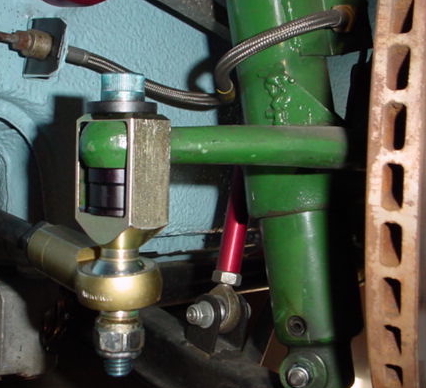 |
  |
1 User(s) are reading this topic (1 Guests and 0 Anonymous Users)
0 Members:

|
Lo-Fi Version | Time is now: 25th April 2025 - 10:32 PM |
Invision Power Board
v9.1.4 © 2025 IPS, Inc.








